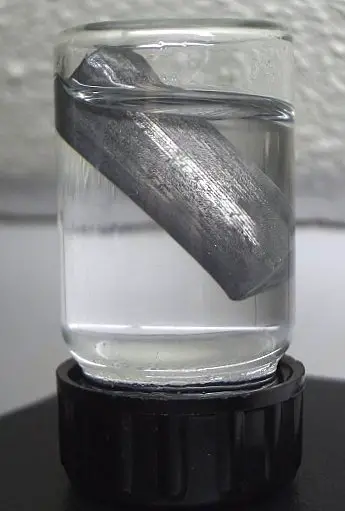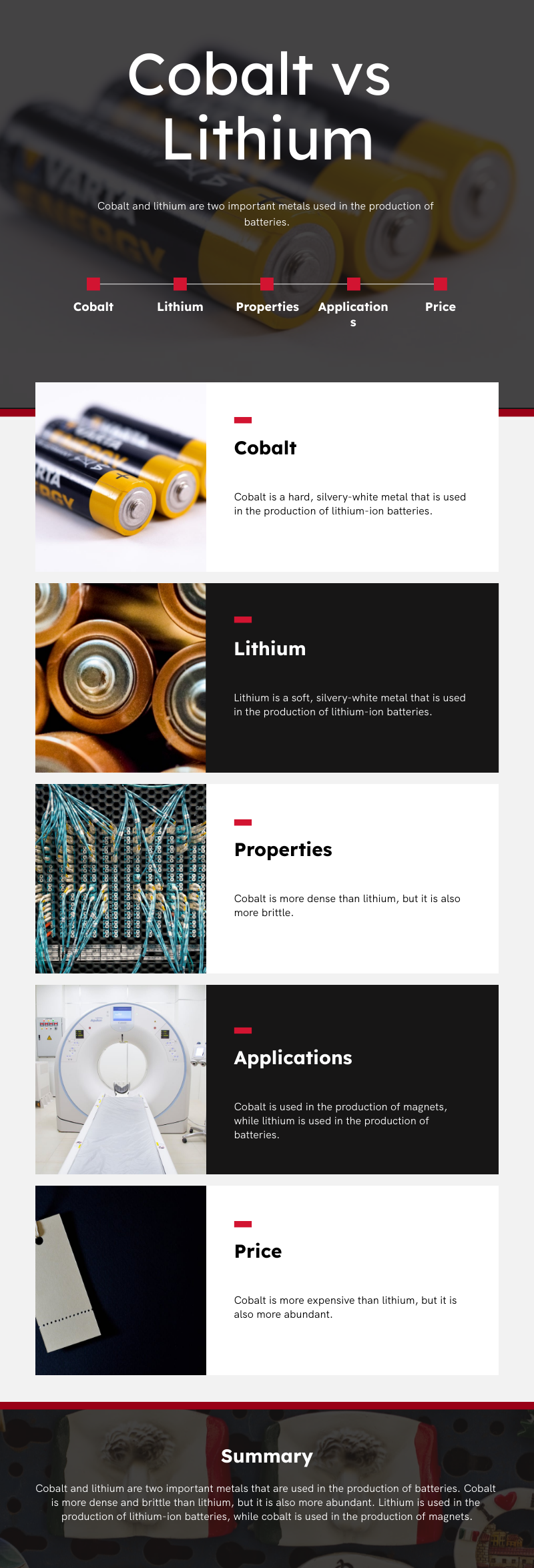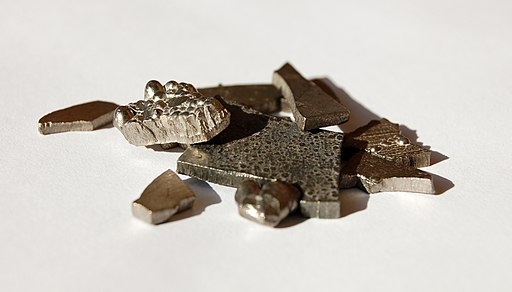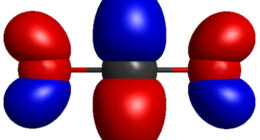Cobalt strengthens alloys and powers lithium-ion batteries, while lithium stores high energy in batteries for various applications.
Did you know that cobalt and lithium play essential roles in powering the devices we use every day? From smartphones to electric vehicles, these elements are critical components in battery technology. But here’s a surprising fact: cobalt, the bluish-gray transition metal, and lithium, the lightweight silvery-white metal, have some remarkable differences that make them unique in the world of batteries.
In this article, we will explore the key differences between cobalt and lithium, their properties, applications, and their roles in battery technology. We’ll also discuss the challenges and future developments in these industries, the environmental impact and sustainability concerns, as well as investment opportunities and market trends.
Key Takeaways:
- Cobalt is a toxic transition metal, while lithium is a nontoxic alkali metal.
- Cobalt is primarily used in the production of alloys and batteries, while lithium is mainly used in batteries for its high energy storage capacity.
- Cobalt mining is often a byproduct of nickel and copper mining, with a significant portion of global production coming from the Democratic Republic of the Congo (DRC). Lithium is extracted from lithium-rich minerals and brines, with major production countries including Australia and China.
- The demand for cobalt and lithium is driven by the growing adoption of electric vehicles, increasing energy storage needs, and the expanding use of portable electronic devices.
- Investing in cobalt and lithium stocks offers opportunities for investors interested in the battery technology sector. Companies involved in cobalt and lithium mining, refining, and battery production are key players in the market.
Overview of Cobalt

Cobalt is a chemical element with the symbol Co and atomic number 27. It is a transition metal that occurs in combination with other elements in the earth’s crust. Cobalt is known for its hard, lustrous bluish-gray appearance and is highly attracted to magnets due to its ferromagnetic properties. It has a high specific gravity and can be attacked by halogens and sulfur.
Cobalt is primarily used in the production of alloys, such as stainless steel and superalloys, due to its ability to enhance strength and corrosion resistance. It is also an essential component in rechargeable batteries, particularly in lithium-ion batteries used in electric vehicles and portable electronics.
Overview of Lithium

Lithium is a chemical element with the atomic number 3 and the symbol Li. It is an alkali metal that is silvery-white in color and can easily be cut with a knife. Lithium is the lightest metal and has the least density among solid metals. It has unique properties that make it a valuable resource in various industries.
Lithium Properties
- High Energy Storage Capacity: Lithium is primarily known for its use in batteries, where it exhibits high energy storage capacity. This characteristic has made lithium-ion batteries the preferred choice for electric vehicles, consumer electronics, and renewable energy storage systems.
- Reactivity: Lithium has the ability to react with nitrogen gas and form lithium nitride. This reactivity makes it valuable in the production of ceramics, glass, and pharmaceuticals.
Lithium Uses
Lithium has a wide range of uses across various industries:
- Battery Technology: Lithium-ion batteries are widely used in electric vehicles, smartphones, laptops, and other portable electronic devices.
- Ceramics and Glass: Lithium compounds are utilized in the production of ceramics and glass, providing improved thermal and electrical properties.
- Pharmaceuticals: Lithium compounds have applications in the medical field, particularly in the treatment of bipolar disorder.
Comparison of Cobalt and Lithium
The main difference between cobalt and lithium lies in their properties and applications. Let’s take a closer look at each element:
Cobalt
Cobalt is a transition metal that is lustrous, bluish-gray in color. It is known for its high specific gravity and magnetic properties. Here are some key properties of cobalt:
- Toxicity: Cobalt is considered toxic and should be handled with care.
- Specific gravity: Cobalt has a higher density compared to lithium.
- Appearance: It has a hard, lustrous bluish-gray appearance.
- Applications: Cobalt is primarily used in the production of alloys and batteries, where it enhances strength and corrosion resistance.
Lithium
Lithium, on the other hand, is an alkali metal and has distinct properties compared to cobalt. Here are some key properties of lithium:
- Toxicity: Lithium is nontoxic and poses no major health hazards.
- Density: Lithium has a low density, making it lightweight and even capable of floating on water.
- Appearance: It is silvery-white in color and can be easily cut with a knife.
- Applications: Lithium finds extensive application in rechargeable batteries, particularly in the electric vehicle industry, due to its high energy storage capacity.
As for their applications, cobalt is mainly used in the production of alloys and batteries, while lithium is primarily used in rechargeable batteries for its high energy storage capacity.
| Properties | Cobalt | Lithium |
|---|---|---|
| Toxicity | Yes | No |
| Specific Gravity | High | Low |
| Appearance | Lustrous bluish-gray | Silvery-white |
| Applications | Production of alloys and batteries | Rechargeable batteries, especially in the electric vehicle industry |
The distinct properties and applications of cobalt and lithium make them suitable for different purposes in various industries, particularly in the rapidly growing battery technology sector.
Cobalt and Lithium in Battery Technology
Cobalt and lithium are integral components in the field of battery technology, playing essential roles in the development of high-performance rechargeable batteries. These batteries are widely used in electric vehicles and portable electronics, powering our modern devices and vehicles.
Cobalt in Batteries
Cobalt, a toxic transition metal, is a critical component in lithium-ion batteries. It acts as a cathode material, contributing to the energy density and stability of the battery. The use of cobalt in batteries enhances their performance, making them more efficient and reliable. Cobalt lithium-ion batteries are known for their longevity and ability to deliver consistent power. They are extensively utilized in various applications, including electric vehicles and portable electronics.
Lithium in Batteries
Lithium, a nontoxic alkali metal, serves as a crucial component in the electrolyte of batteries. It facilitates the movement of lithium ions between the cathode and anode, allowing for the efficient storage and release of energy. Lithium-ion batteries, which utilize lithium as a key ingredient, are highly sought after due to their high energy storage capacity and long lifespan. These batteries have revolutionized the battery industry, enabling advancements in electric mobility and portable electronic devices.
Overall, the combination of cobalt and lithium in battery technology has resulted in the development of reliable, high-performance rechargeable batteries. These batteries have transformed various industries, providing sustainable energy solutions and powering our modern world.
Cobalt and Lithium Mining
Cobalt and lithium are essential elements in the battery technology industry, with their demand driven by the growing adoption of electric vehicles and renewable energy storage systems. Understanding the mining processes and geographical distribution of cobalt and lithium production is vital for ensuring a consistent supply of these critical materials.
Cobalt Mining
Cobalt is predominantly mined as a byproduct of nickel and copper mining operations around the world. The Democratic Republic of the Congo (DRC) is the leading producer of cobalt, accounting for a significant portion of global production. The cobalt ore is extracted through both underground and open-pit mining methods.
Lithium Mining
Lithium mining involves the extraction of lithium-rich minerals such as spodumene or brines. Major lithium production countries include Australia, China, and various Latin American nations. Australia, in particular, boasts significant lithium reserves and is a major supplier to the global lithium market.
The mining process for lithium varies depending on the source. Spodumene, a hard rock mineral, is typically mined through open-pit or underground methods. In contrast, lithium brines are extracted from underground reservoirs and evaporation ponds, where the brine is left to evaporate, leaving behind concentrated lithium compounds.
Supply and Production Factors
The supply and production of cobalt and lithium are influenced by various factors, including geopolitical risks, evolving market demand, and environmental concerns. The geopolitical landscape can impact the availability and accessibility of cobalt and lithium reserves, as well as the stability of mining operations in certain regions.
Environmental considerations play a crucial role in the sustainable production of cobalt and lithium. Mining operations must adhere to responsible practices to minimize their impact on local ecosystems. Moreover, as the demand for battery materials continues to rise, ensuring a steady supply of cobalt and lithium becomes critical for the development of clean energy technologies.
The table below presents an overview of cobalt and lithium mining:
| Cobalt Mining | Lithium Mining | |
|---|---|---|
| Primary Production Regions | Democratic Republic of the Congo (DRC), Canada, Australia, Russia | Australia, Argentina, Chile, China, Zimbabwe |
| Main Extraction Methods | Byproduct of nickel and copper mining | Hard rock mining (spodumene) Lithium brine extraction |
| Leading Producers | DRC, Russia, Australia | Australia, Chile, China |
Understanding the mining processes and global distribution of cobalt and lithium production enables stakeholders to monitor and respond to supply chain dynamics, ensuring the availability of these crucial battery materials.
Cobalt and Lithium Stocks
Investing in cobalt and lithium stocks is gaining popularity as the demand for these materials rises with the growth of battery technologies. Companies involved in cobalt and lithium mining, refining, and battery production are attracting investors interested in long-term growth prospects. Major players like Glencore and China Molybdenum dominate the mining sector, offering exposure to cobalt and lithium markets through their diversified operations worldwide. Additionally, battery manufacturers such as Tesla and Panasonic present investment opportunities, with Tesla being a leader in lithium-ion battery production and Panasonic supplying batteries to Tesla.
When considering investments in cobalt and lithium stocks, investors should assess factors like financial performance, production capabilities, and supply chain sustainability. Evaluating a company’s profitability, growth potential, and commitment to responsible sourcing and ethical mining practices is crucial for informed investment decisions. As the demand for cobalt and lithium continues to rise, investors are keen on supporting companies that can meet these demands while prioritizing environmental and social responsibilities.
Top Companies in the Cobalt and Lithium Sectors
| Company | Main Operations | Market Cap |
|---|---|---|
| Glencore | Cobalt and lithium mining | $XX billion |
| China Molybdenum | Cobalt and lithium mining | $XX billion |
| Tesla | Electric vehicle and battery manufacturing | $XX billion |
| Panasonic | Battery manufacturing | $XX billion |
Table: Overview of top companies in the cobalt and lithium sectors.
Investing in cobalt and lithium stocks can be an attractive opportunity for those looking to participate in the growing battery technology industry. By carefully evaluating the financial performance, production capabilities, and supply chain sustainability of companies, investors can make informed decisions and potentially benefit from the long-term growth of the cobalt and lithium markets.

Cobalt and Lithium Demand
The demand for cobalt and lithium is on the rise due to several factors driving the growth of the electric vehicle and renewable energy industries. As the world transitions to a cleaner and more sustainable energy system, the importance of cobalt and lithium in powering these sectors cannot be overstated.
The Growing Adoption of Electric Vehicles
One of the main drivers of cobalt and lithium demand is the increasing adoption of electric vehicles (EVs) worldwide. As governments and consumers prioritize reducing carbon emissions, EVs have emerged as a viable alternative to traditional gasoline-powered vehicles. The batteries used in EVs rely heavily on cobalt and lithium to provide the necessary energy storage capacity required for longer driving ranges.
The International Energy Agency (IEA) predicts that the global electric car stock will reach 145 million by 2030, representing a significant increase from the current levels. This surge in electric car production will undoubtedly drive up the demand for cobalt and lithium in the coming years.
Expanding Energy Storage Needs
Another significant factor contributing to the demand for cobalt and lithium is the need for energy storage solutions. As the world seeks to integrate more renewable energy sources into the power grid, efficient energy storage becomes essential to balance the supply and demand variability inherent in renewable sources.
Cobalt and lithium play a crucial role in the development of large-scale energy storage systems. These batteries help store excess renewable energy generated during periods of high production and release it during times of increased demand or when renewable sources are not as active. This enhances grid stability and enables a more reliable and efficient energy infrastructure.
ion units annually by 2040, representing 31% of all vehicle sales. This massive increase in EV adoption will undoubtedly drive the demand for cobalt and lithium in the battery market.
Similarly, the International Renewable Energy Agency (IREA) projects that global renewable energy capacity will double by 2030, with significant investments in solar and wind power. This growth will further increase the demand for cobalt and lithium batteries to store and utilize the generated renewable energy efficiently.
Opportunities in the Battery and Resource Industries
The increasing demand for cobalt and lithium presents lucrative opportunities for stakeholders in the battery and resource industries. Mining companies involved in the extraction and production of cobalt and lithium will see a surge in demand for their products.
In addition, battery manufacturers and technology companies investing in research and development to improve the performance and efficiency of cobalt-lithium batteries will benefit from the growing market. These advancements will enable the development of more powerful and longer-lasting batteries, further boosting the demand for cobalt and lithium.
Overall, the outlook for cobalt and lithium demand is highly positive, driven by the global shift towards sustainable energy systems and the increasing adoption of EVs. As these trends continue to unfold, stakeholders in the battery and resource industries will play a crucial role in meeting the growing demand for cobalt and lithium.
Challenges and Future Developments
The cobalt and lithium industries encounter several challenges, especially concerning ethical practices in cobalt mining in the Democratic Republic of the Congo (DRC). These concerns highlight the importance of responsible sourcing and human rights protection. Moreover, supply chain disruptions and price fluctuations pose risks to the future availability of cobalt, prompting the need for stable production and distribution mechanisms.
In lithium production, challenges revolve around water usage and waste management, calling for sustainable practices to mitigate environmental impacts. To address these issues, ongoing research focuses on developing solid-state batteries. These batteries offer enhanced safety, increased energy density, and longer lifespans by replacing traditional liquid electrolytes with solid-state alternatives. This innovation has the potential to reduce reliance on cobalt and lithium, marking a significant advancement in battery technology.
| Challenges | Solutions |
|---|---|
| Ethical concerns in cobalt mining | Encouraging responsible sourcing and transparent supply chains |
| Supply chain disruptions and price volatility | Diversifying sources and improving resource efficiency |
| Environmental challenges in lithium production | Implementing sustainable practices and exploring alternative extraction methods |
| New battery technologies | Advancing solid-state batteries and exploring alternative cathode materials |
These advancements in battery chemistry and the ongoing efforts to overcome challenges reflect the industry’s commitment to advancing sustainable and efficient battery technologies. As technology continues to evolve, it is important to prioritize innovation and collaboration to ensure a greener and more sustainable future for cobalt and lithium in the battery technology sector.
Environmental Impact and Sustainability
The environmental impact of cobalt and lithium extraction and processing poses challenges for sustainability. Cobalt mining, particularly in the Democratic Republic of the Congo (DRC), raises concerns about environmental damage and human rights issues. Similarly, lithium production requires significant water usage and can lead to pollution, highlighting the need for sustainable practices in both industries.
Efforts to address these challenges include recycling initiatives for cobalt and lithium batteries, reducing the demand for new mining activities and minimizing environmental harm. Additionally, advancements in recycling technologies aim to efficiently recover cobalt and lithium from end-of-life batteries, contributing to resource conservation and environmental protection. Prioritizing sustainability and transparency in supply chains, along with responsible mining practices and cleaner extraction methods, are essential for the cobalt and lithium industries to ensure a greener and more sustainable future.
Environmental Impact Comparison of Cobalt and Lithium
| Environmental Impact Factors | Cobalt | Lithium |
|---|---|---|
| Extraction Method | Primarily obtained as a byproduct of nickel and copper mining, which can result in environmental degradation and human rights concerns in certain regions. | Extracted from lithium-rich minerals or brines, involving large-scale water consumption and potential pollution. |
| Processing | Involves smelting and refining processes that can generate emissions and waste products, contributing to air and water pollution. | Requires energy-intensive processing, resulting in carbon emissions and potential pollution if not properly managed. |
| Disposal | Improper disposal of cobalt-containing batteries can lead to environmental contamination. | End-of-life lithium batteries can pose disposal challenges due to the potential release of toxic materials. |
| Recycling Potential | Significant potential for recycling cobalt from batteries, reducing the need for new mining activities. | High recycling potential for lithium, promoting resource conservation and reducing environmental impacts. |
The table above illustrates the environmental impact of cobalt and lithium across various stages of their lifecycle. While both elements have associated environmental challenges, implementing sustainable practices and prioritizing recycling initiatives can help mitigate their environmental footprints and contribute to a more sustainable future.
Investment Opportunities and Market Trends
The growing demand for cobalt and lithium presents exciting investment opportunities across various sectors. While mining and battery manufacturing companies are obvious choices, there are also thriving markets for suppliers of mining equipment, battery components, and recycling technologies. In addition, the development of advanced battery technologies like solid-state batteries and lithium-sulfur batteries opens up new frontiers for investment.
Market trends point towards an increasing emphasis on sustainable and ethical sourcing of cobalt and lithium. Stakeholders in the industry are actively exploring ways to ensure responsible mining practices and transparent supply chains to meet the growing demand. Similarly, the integration of battery energy storage systems with renewable energy installations is another promising trend.
Investment Opportunities:
- Mining equipment suppliers
- Battery component manufacturers
- Recycling technology providers
- Companies involved in the development of advanced battery technologies
Market Trends:
- Focus on sustainable and ethical sourcing of cobalt and lithium
- Integration of battery energy storage systems with renewable energy
Understanding these investment opportunities and market trends can provide valuable insights for investors looking to capitalize on the cobalt and lithium sectors. By staying informed and aligning investments with the changing landscape, investors can position themselves for potential growth in these markets.
| Investment Opportunities | Market Trends |
|---|---|
| Mining equipment suppliers | Focus on sustainable and ethical sourcing of cobalt and lithium |
| Battery component manufacturers | Integration of battery energy storage systems with renewable energy |
| Recycling technology providers | |
| Companies involved in the development of advanced battery technologies |
Conclusion
In summary, cobalt and lithium are essential elements in battery technology, each with its unique properties and roles. Cobalt, though toxic, strengthens alloys and is crucial in lithium-ion batteries, while lithium, nontoxic and with high energy storage capacity, is pivotal in battery efficiency.
The demand for cobalt and lithium is rising due to increased electric vehicle adoption and the need for effective energy storage. However, challenges such as supply, sustainability, and environmental impact must be addressed for the industry’s long-term health. Investors can seize opportunities in this evolving sector by understanding market trends, embracing sustainable practices, and staying informed about advancements in battery technologies.
FAQ
What is the difference between cobalt and lithium?
The key difference is that cobalt is a toxic transition metal, while lithium is a nontoxic alkali metal. Cobalt is used in the production of alloys and batteries, whereas lithium is primarily used in batteries for its high energy storage capacity.
What are the properties of cobalt?
Cobalt is a hard, lustrous bluish-gray metal that occurs in combination with other elements. It has a high specific gravity and is highly attracted to magnets. Cobalt is known for enhancing strength and corrosion resistance in alloys.
What are the properties of lithium?
Lithium is a lightweight silvery-white metal that can float on water. It is the lightest metal and has the least density among solid metals. Lithium is primarily known for its high energy storage capacity in batteries.
What are the uses of cobalt?
Cobalt is mainly used in the production of alloys, such as stainless steel and superalloys, due to its ability to enhance strength and corrosion resistance. It is also an essential component in rechargeable batteries, especially in lithium-ion batteries used in electric vehicles and portable electronics.
What are the uses of lithium?
Lithium is primarily used in batteries, where it provides high energy storage capacity. It is widely used in lithium-ion batteries for electric vehicles, consumer electronics, and renewable energy storage systems. Lithium is also used in the production of ceramics, glass, and pharmaceuticals.
How are cobalt and lithium used in battery technology?
Cobalt is used as a cathode material in lithium-ion batteries, enhancing the energy density and stability of the battery. Lithium, on the other hand, serves as a key component in the battery’s electrolyte, facilitating the movement of lithium ions between the cathode and anode for energy storage.
Where are cobalt and lithium mined?
Cobalt is predominantly mined as a byproduct of nickel and copper mining, with a significant portion of global production concentrated in the Democratic Republic of the Congo (DRC). Lithium mining involves extracting lithium-rich minerals or brines, with major production countries including Australia, China, and Latin American nations.
Are there investment opportunities in cobalt and lithium stocks?
Yes, there are opportunities for investors interested in cobalt and lithium stocks. Major mining companies with cobalt and lithium operations include Glencore and China Molybdenum, while battery manufacturers like Tesla and Panasonic also play a crucial role. Evaluating financial performance, production capabilities, and supply chain sustainability is important when considering investments.
What drives the demand for cobalt and lithium?
The demand for cobalt and lithium is driven by the growing adoption of electric vehicles, increasing energy storage needs, and the expanding use of portable electronic devices. The transition towards a cleaner and more sustainable energy system is a major driver for the increased demand for cobalt and lithium in batteries.
What are the challenges and future developments for cobalt and lithium?
Challenges include potential supply chain disruptions, environmental concerns, and evolving market demand. Ongoing research is focused on finding alternative battery technologies that minimize the use of cobalt and lithium. Advances in battery chemistry, such as solid-state batteries and new cathode materials, have the potential to reshape the cobalt and lithium landscape in the future.
What is the environmental impact of cobalt and lithium?
Cobalt mining has been linked to environmental degradation and human rights concerns, particularly in the Democratic Republic of the Congo. Lithium production involves large-scale water consumption and potential pollution. However, recycling initiatives for cobalt and lithium batteries are gaining momentum to minimize environmental impacts.
Are there investment opportunities and market trends in cobalt and lithium?
Yes, apart from mining and battery manufacturing companies, there is a thriving market for suppliers of mining equipment, battery components, and recycling technologies. The development of advanced battery technologies and the integration of battery energy storage systems with renewable energy installations also present investment prospects. Sustainable and ethical sourcing of cobalt and lithium is a growing trend.
Source Links
- https://www.differencebetween.com/what-is-the-difference-between-cobalt-and-lithium/
- https://history-computer.com/nickel-cobalt-vs-lithium-iron-batteries-compared-pros-cons-and-differences/
- https://www.mckinsey.com/industries/metals-and-mining/our-insights/lithium-and-cobalt-a-tale-of-two-commodities
Image Credits
Featured Image By – Benjah-bmm27, Public domain, via Wikimedia Commons
Image 1 By – Hi-Res Images ofChemical Elements, CC BY 3.0 <https://creativecommons.org/licenses/by/3.0>, via Wikimedia Commons
Image 2 By – W. Oelen, CC BY-SA 3.0 <https://creativecommons.org/licenses/by-sa/3.0>, via Wikimedia Commons









